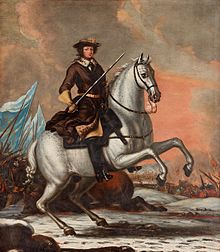Strömsholm Palace

Strömsholm Palace, sometimes called Strömsholm Castle (
History

King
The old palace of the 1550s later provided the foundation for the present Strömsholm Palace, built in 1669–1674 for
Work on the interiors came to a halt when the building's fabric was completed. Not until the 1730s was the first phase of interior work carried out, including a palace
The palace also houses an important collection of Swedish paintings from the 17th century, amongst others David Klöcker Ehrenstrahl's paintings of King Charles XII's horses. Since the 16th century, Strömsholm has been an equestrian center of Sweden. In the 1550s, King Gustav Vasa reinforced the importance of horses here, by raising horses for the cavalry. The Swedish Army Riding and Horse-Driving School at Strömsholm was a part of the Swedish Army from 1868 to 1968. Today, Strömsholm is used as a hippodrome, where equestrian competitions are held each year.

In 1985, the palace underwent major renovation of its façade. Over the years, the exterior had undergone various alterations, but the plasterwork as originally applied in the 1670s was largely intact. The roof was covered with tar shingles until the 19th century, when they were replaced with tin. The palace was restored in stages during the 1990s. The disposition of the rooms in the royal apartments was restored, and the 18th-century furnishings were placed in the correct context. One of the most important features of the restoration was the reproduction of the 1760s wallpaper, the original of which was found in isolation on an attic beam in one of the houses on the estate. Old linen towels were transformed into royal wallpaper.
References
- Bedoire, Fredric (2006). Svenska slott och herrgårdar (in Swedish). Stockholm: Bonnier. ISBN 91-0-010577-5.
59°31′29″N 16°16′11″E / 59.52472°N 16.26972°E
External links
- Strömsholm Palace - official site

